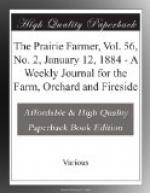Resolved, That the President of
this association be requested
to appoint a committee to draft
a bill embodying the sense of
this meeting in reference to a wolf
and dog law.
BUSINESS.
The next meeting of the Association will be held at Ottumwa, commencing the first Tuesday in December next.
Col. Scott is to prepare and publish the proceedings of this meeting. The edition will be 5,000 copies.
The following are the officers for 1884: President, C.F. Clarkson; Vice-presidents, H.C. Wheeler, B.F. Elbert, R. Stockdale, H. Wallace, W.H. Jordan, E.W. Lucas, and P. Nichols; Secretary and Treasurer, Fitch B. Stacy.
THE HORSE AND HIS TREATMENT.
NUMBER ONE.
History chronicles no improvement in the horse made by the agency of man. The horses of the days of Pharaoh, or of Homer, have their superiors in no part of the civilized world to-day. The Arabs have for ages been noted for the excellence of their horses, but that excellence was not created, nor has it been increased by the arts of man. Since the time of Cromwell the horses of England have steadily degenerated. Those most conversant with the matter say that this degeneracy has been the most marked and rapid during the last fifty years. The horses of this country lack the value of their ancestors of the Revolutionary period. Nowhere, or at no time, can man boast of improving the horse by the arts of breeding. What is the reason of this?
The horse, the ox, the hog, and the sheep comprise the four great classes of domesticated farm animals. In certain directions man has improved these three last. These improvements have made them more valuable. The ox has been bred to make more flesh from the same amount of food, and to lay on fat at an earlier age; the cow has been bred to give instead of a supply of milk barely large enough to sustain her young, a bountiful yield, and of a richer quality; the hog has been bred into a veritable machine to convert food into pork; the sheep has been bred to yield more wool, and of a finer texture, and to make more mutton. All these changes have been beneficial because the value of the animal lay in its production of beef, milk, pork, wool, or mutton, as the case might be. It is true that these changes have been accomplished at the expense of vigor and endurance. These two qualities are important in the hog, ox, or sheep, but those that have been developed so far overshadow their lessening that on the whole we can say that the arts of man have improved our kine, swine, and sheep.




